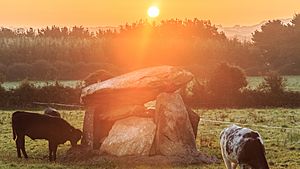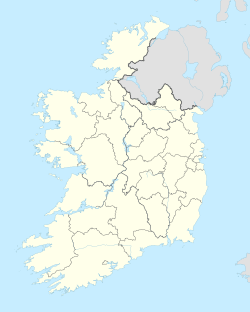Ballynageeragh Portal Tomb facts for kids
|
Cromleac Bhaile na gCiarraíoch
|
|

The tomb at sunrise
|
|
| Alternative name | Ballinageerah Dolmen |
|---|---|
| Location | Ballynageeragh, Dunhill, County Waterford |
| Region | Ireland |
| Coordinates | 52°10′40″N 7°16′37″W / 52.177811°N 7.276862°W |
| Type | dolmen |
| History | |
| Material | stone |
| Founded | 4000–3000 BC |
| Periods | Neolithic |
| Site notes | |
| Condition | Poorly reconstructed |
| Ownership | Veale family |
| Public access | Yes |
| Reference no. | 384 |
The Ballynageeragh Portal Tomb is an ancient stone structure called a dolmen. It's a very special place, recognized as a National Monument in County Waterford, Ireland.
Contents
Where is Ballynageeragh Portal Tomb?
This ancient tomb is found in a grassy field. It's about 1 kilometer (or two-thirds of a mile) northwest of a village called Dunhill. The tomb is also close to where the Annestown River begins.
A Look Back in Time: History of the Tomb
When Was It Built?
People built dolmens like this one a very long time ago. They were constructed in Ireland during the Neolithic period, which was between 4000 and 3000 BC. That's over 5,000 years ago!
What Did We Find Inside?
In the late 1930s, experts looked closely at the tomb. They found some interesting things inside its main chamber. They discovered small pieces of bone that had been burned, along with flint (a type of stone used for tools) and charcoal. These findings help us learn about the people who used the tomb long ago.
How Was It Rebuilt?
The tomb was put back together in 1940. It had likely fallen apart over thousands of years. The reconstruction wasn't perfect, but it helped preserve the monument for us to see today.
What Does the Tomb Look Like?
The Capstone
The most noticeable part of the dolmen is its large, oval-shaped top stone, called a capstone. This huge stone measures about 4 meters long, 2.65 meters wide, and 0.7 meters thick. It weighs a massive 6¾ tons!
Missing Stones and Direction
The tomb originally had two tall stones at the front, called portal-stones, but these are now missing. The tomb faces southwest, which means it points towards where the sun sets.
How the Stones Fit Together
The heavy capstone rests on a "doorstone" and a "cushion stone." The cushion stone sits on top of the back stone, helping to support the capstone. There are also several other stones around the sides that make up the structure of the tomb.


